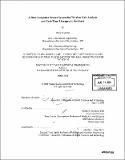A shoe-integrated sensor system for wireless gait analysis and real-time therapeutic feedback
Author(s)
Morris, Stacy J., 1974-
DownloadFull printable version (15.81Mb)
Other Contributors
Harvard University--MIT Division of Health Sciences and Technology.
Advisor
Joseph A. Paradiso.
Terms of use
Metadata
Show full item recordAbstract
Clinical gait analysis currently involves either an expensive analysis in a motion laboratory, using highly accurate, if cumbersome, kinematic systems, or a qualitative analysis with a physician or physical therapist making visual observations. There is a need for a low cost device that falls in between these two methods, and can provide quantitative and repeatable results. In addition, continuous monitoring of gait would be useful for real-time physical rehabilitation. To free patients from the confines of a motion laboratory, this thesis has resulted in a wireless wearable system capable of measuring many parameters relevant to gait analysis. The extensive sensor suite includes three orthogonal accelerometers, and three orthogonal gyroscopes, four force sensors, two bi-directional bend sensors, two dynamic pressure sensors, as well as electric field height sensors. The "GaitShoe" was built to be worn on any shoes, without interfering with gait, and was designed to collect data unobtrusively, in any environment, and over long periods of time. Subject testing of the GaitShoe was carried out on ten healthy subjects with normal gait and five subjects with Parkinson's disease. The calibrated sensor outputs were analyzed, and compared to results obtained simultaneously from The Massachusetts General Hospital Biomotion Lab; the GaitShoe proved highly capable of detecting heel strike and toe off, as well as estimating orientation and position of the subject. A wide variety of features were developed from the calibrated sensor outputs, for use with standard pattern recognition techniques to classify the gait of the subject. The results of the classification demonstrated the ability of the GaitShoe to identify the subjects with (cont.) Parkinson's disease, as well as individual subjects. Real-time feedback methods were developed to investigate the feasibility of using the continuous monitoring of gait for physical therapy and rehabilitation.
Description
Thesis (Sc. D.)--Harvard-MIT Division of Health Sciences and Technology, 2004. Includes bibliographical references (p. 307-314).
Date issued
2004Department
Harvard University--MIT Division of Health Sciences and TechnologyPublisher
Massachusetts Institute of Technology
Keywords
Harvard University--MIT Division of Health Sciences and Technology.